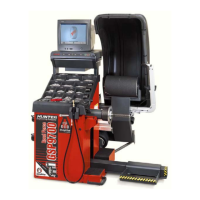GSP9700 Series Road Force Measurement System Operation 4. Balancing a Wheel 69
As the wheel assembly is rotated on the spindle, the dial indicator gauges will change
to display current information for each dial indicator gauge position.
ASSEMBLY
LOADED RUNOUT
DIAL INDICATOR
LATERAL RIM RUNOUT
DIAL INDICATORS
RADIAL RIM RUNOUT
DIAL INDICATORS
“Hide Dial Indicators” can be selected to remove the dial indicator gauges from the
screen. Rim runout and loaded runout will still be graphically depicted on the screen.
Lateral/Radial Rim High Spot Indicators Feature
The “Show Lateral High Spot(s)” and “Show Radial High Spot(s)” softkeys are
available to select a graphic depiction of the exact radial (blue indicators) or lateral
(orange indicators) first harmonic runout high spot locations. The high spots indicated
are the high spots of the first harmonic, NOT the T.I.R. runout high spots. The
lateral/radial high spots correspond to the lateral and radial first harmonic rim runout
amounts on the left side of “Current QuickMatch Measurements” screen. Located 180
degrees from the rim matching mark is a green indicator that will appear between the
rim lips to identify the rim average 1st harmonic high spot.
Encountering ForceMatching™ or QuickMatching™ Prediction Errors
Below are some reasons why the GSP9700 may not match or quantify the value of
the tire or the assembly.
Incorrect Mechanical Wheel Mounting on the Shaft:
This can be caused from worn or damaged adaptors, rust, or debris on the
wheel, shaft, hub, adaptors, or a cone contacting a wheel on an irregular surface.
Verify proper mounting by performing a centering check.
External Rim Measurement vs. Actual Bead Seat Measurement:
There is a high correlation between external and internal measurement, however
the operator must consider each wheel design individually. Some cast or closed-
faced wheels cannot be accurately measured externally. The tire must be
removed for accurate bead seat runout measurements.
Incorrect Tire Bead Seating Procedures:
Tire technology is always changing. Today’s vehicles require the tire to be
designed to tightly adhere to the wheel, preventing slippage between the two
components. As a result, incorrect tire bead seating procedures are becoming
more of an issue in solving vibration complaints. In many cases, a wheel will
display high non-uniformity values because of increased tire bead interference,
wheel design, or improper bead seating procedures. If the tire is re-loosened
from the wheel and properly lubricated and remounted, the level of non-
uniformity may decrease dramatically. On sensitive vehicles, sometimes there is
benefit to slightly over-inflating the tire, deflating the air, and then re-inflating to
optimize bead seating.
Insufficient Use of Tire Mounting Lube During Mounting:
“Lube is Good!” Proper lubrication on the tire bead and rim areas including bead
seat, hump, balcony, and drop center are vital in achieving proper seating of the
tire bead to the wheel assembly. Aggressive acceleration or braking should be
avoided for the first 500 miles to prevent tire to wheel slippage.

